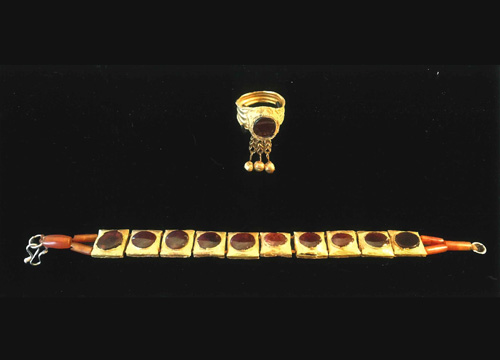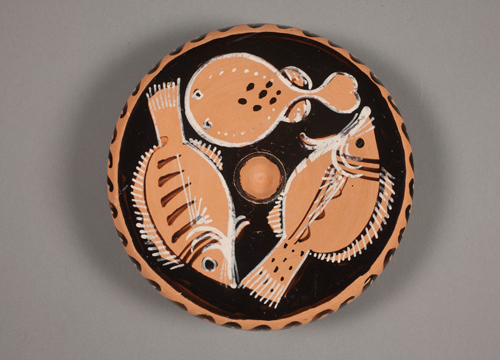Bronze torso, Collection of Doug and Anemarie Gold

What materials will survive?
Material matters:

Bronze torso, Collection of Doug and Anemarie Gold
Monumental bronze torso
Roman, 3rd century CE
Collection of Doug and Anemarie Gold
Catalogue #329
The ancient Greeks and Romans were highly skilled in casting sculptures using bronze, a metal that offered strength, but still allowed artists to make natural shapes and forms. Despite this, large scale bronze statues have rarely survived from antiquity, as they were often melted down so that their valuable metal could be reused.
Many bronze sculptures in Museum collections today have been preseved only because they were completely buried for many centuries in archaeological sites.
Gold and garnet bracelet and ring
Roman, 1st-3rd century CE
Collection of Doug and Anemarie Gold
Catalogue #321
Metal objects made from copper or iron break down slowly over time, slowly turning into little more than rust.
Objects made from gold however, can sometimes come out of the ground looking as appealing as the day they were made. It is not surprising that ancient cultures valued gold and used it to make treasured objects like this Roman jewellery set, just as we continue to do today.

Bracelet and ring, Collection of Doug and Anemarie Gold

Campanian red-figure fish plate
Attributed to the Three Stripe Painter, c. 330-320 BCE
Donated by M.K. Steven, 1969
JLMC 102.69, James Logie Memorial Collection
Alongside stone tools, ceramics are some of the longest lasting examples of man-made objects. They are very important to archaeology because they often survive exposure to light, water and wind.
Even when they are broken, the pieces of ceramic vessels, (known as sherds) can survive for hundreds of years, and provide a great deal of information about methods of manufacture, styles of decoration, and the ways in which whole vessels would have been used.

JLMC 28.53, Glass flask
Glass flask
Roman, 2nd century CE
Donated by the Nicholson Museum, University of Sydney, 1953
JLMC 28.53, James Logie Memorial Collection
This Roman green glass flask is believed to have been excavated in Cannon Street in the city of London. By the end of the 1st century CE Londinium, (London), was Roman Britain’s largest planned city with a population of 60,000 people.
Glass vessels were mass produced after the glassblowing technique was invented by the end of the 1st century BCE, and glass became an affordable commodity that people of all classes could use. However, despite being produced in large numbers, ancient glass vessels seldom survive intact, because they are fragile and easily broken.